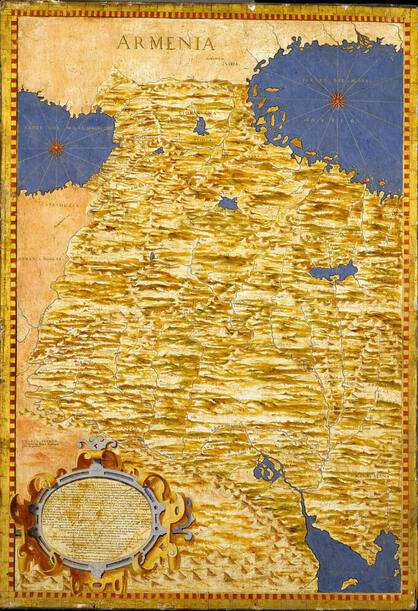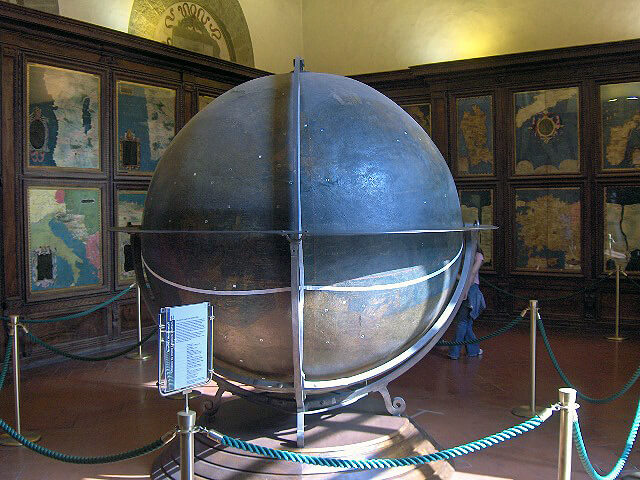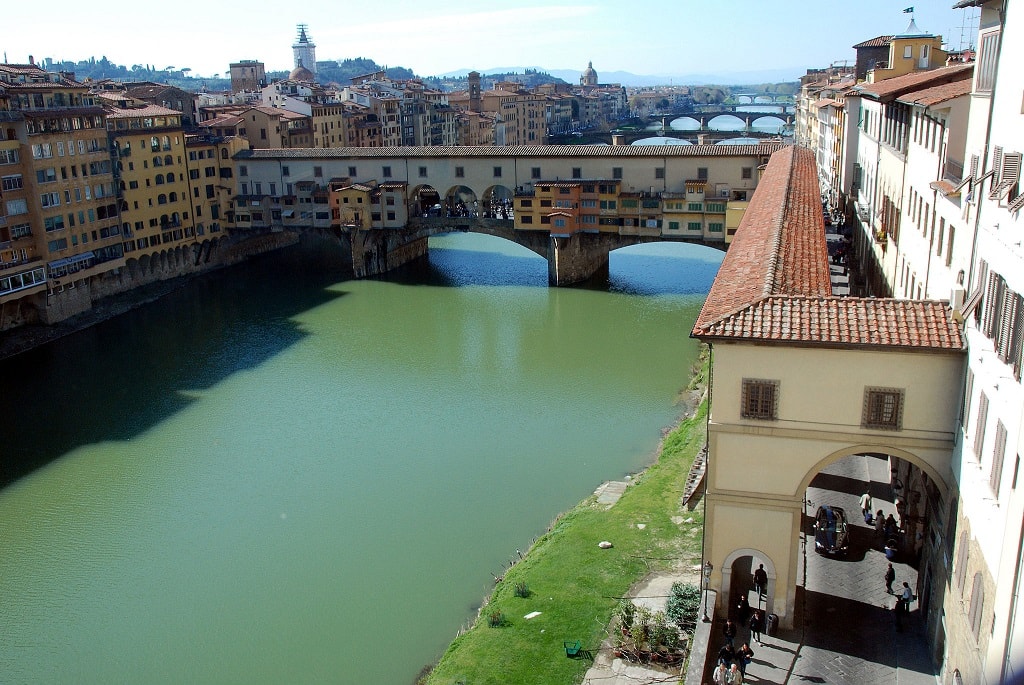|
Where? Room on the Second Floor of the Palazzo Vecchio
When? 1561-1565 Commissioned by? Duke Cosimo I de’ Medici Designed by? Giorgio Vasari designed the room in conjunction with cosmographer Fra’ Miniato Pitti. Egnazio Danti completed the painting of the map of Armenia. What do you see? This room shows the world as known in 1563. It was supposed to show both the terrestrial view (the maps of the countries in the world) and the celestial view (the map of the sky). Nowadays, this hall provides dozens of geographical maps painted on leather. The maps range from Japan to Brazil, and from the North Pole to the South Pole. More precisely, the room houses 53 maps. The first 30 have been completed by Egnazio Danti while Duke Cosimo I was still alive. After his death, the son of Cosimo I, Francesco I, hired Stefano Bonsignori to complete the remaining 23 maps. The maps are very precise, based on the knowledge of that time, and contain impressive details, including information about the wind and other typical features of each territory. In the middle of the room stands the largest rotating globe of its era, created by Matteo Neroni in 1567. Finally, the ceiling was supposed to be decorated with the 48 constellations but has never been completed.
Backstory: Duke Cosimo I de’ Medici asked Vasari to design this room that would show the whole world as known at that time. The room also contained many of the most valuable objects that the Medici family collected, stored in large cupboards made of walnut wood. These objects included scientific instruments, small statues, and tapestries. The maps were created on top of the cupboard doors. The room also served the purpose of celebrating the duke as the lord of the universe. This may be related to his name Cosimo, which was his birth name, and which was derived from the Greek word ‘kosmos’, which means 'universe'.
Who is Duke Cosimo I de’ Medici? Cosimo I de’ Medici (1519-1574) was born in Florence and was the Duke of Florence from 1537-1569, after which he became the Grand Duke of Tuscany until his death. Cosimo was part of a rich banking family that was already a political dynasty since the 14th century. Cosimo was very interested in geography, natural sciences, and trade. Like his ancestors, he was an important supporter of the development and preservation of art during his life. For example, he has given Giorgio Vasari the task to create the building of the Uffizi Museum and the Vasari Corridor. However, Cosimo also commissioned the Palazzo Pitti and the Boboli gardens.
Who is Giorgio Vasari? Giorgio Vasari (1511-1574) was an architect, historian, painter, and writer. He is best known for his book (Amazon link) describing the lives of many of the most well-known Renaissance artists. He has been instrumental in the design of the Palazzo Vecchio as we experience it today. He was involved in the design of many of the elements of the palace, including the Hall of the Five Hundred, the staircase leading up to the Hall of the Five Hundred, the Studiolo of Francesco I, and the staircase up to the second floor.
Fun fact: The Palazzo Vecchio is full of secret entrances and hidden rooms. Behind the map of Armenia, there is a secret door that leads to a private studio. This studio served multiple purposes over time. It has been used by the inhabitants of the palace to bring their lovers for some intimacy, but also to torture their enemies. The studio leads to a stairway with a small opening where corpses could conveniently be dumped in the nearby river. While these kinds of hidden studios were typically reserved for the male inhabitants, it was initially used by Duchess Bianca Cappello, the daughter-in-law of Cosimo I, who secretly married to Cosimo’s son Francesco I. Interested in a copy for yourself? A short book with illustrations from the maps in this room (Amazon link)
Written by Eelco Kappe
References:
0 Comments
Leave a Reply. |
Categories
All
|
- Home
- Blog
-
Museums
- Alte Pinakothek
- Art Institute of Chicago
- Baltimore Museum of Art
- Barber Institute of Fine Arts
- Bargello
- Barnes Foundation
- British Museum
- Church of Sant’Anastasia
- Cleveland Museum of Art
- Courtauld Institute of Art
- Detroit Institute of Arts
- Frans Hals Museum
- Galleria Borghese
- Gallerie dell'Accademia
- Getty Museum
- Guggenheim
- Hermitage Museum
- Kunsthistorisches Museum
- Kunstmuseum Basel
- Legion of Honor Museum
- Louvre
- Mauritshuis
- Metropolitan Museum of Art
- Musee d’Orsay
- Museum of Fine Arts in Boston
- Museum of Modern Art
- National Gallery in London
- National Gallery of Art
- National Museum in Poznań
- Norton Simon Museum
- Ny Carlsberg Glyptotek
- Palace of Versailles
- Palazzo Pitti
- Palazzo Vecchio
- Petit Palais
- Philadelphia Museum of Art
- Prado
- Pushkin Museum
- Ravenna Art Museum
- Rijksmuseum
- San Diego Museum of Art
- Santa Maria delle Grazie
- St. Peter's Basilica
- Städel Museum
- Statens Museum for Kunst
- Tate Britain
- Tate Modern
- Timken Museum of Art
- Uffizi
- Vatican Museums
- Wallace Collection
-
Artists
- Altdorfer
- Anguissola
- Berlin Painter
- Bosch
- Botticelli
- Boucher
- Bronzino
- Bruegel the Elder
- Brunelleschi
- Cabanel
- Caillebotte
- Canova
- Caravaggio
- Carpeaux
- Cezanne
- Cimabue
- David
- Degas
- Delacroix
- De Maria
- Donatello
- El Greco
- Fontana
- Fra Angelico
- Fragonard
- Gauguin
- Gentileschi
- Gericault
- Gonzalez-Torres
- Goya
- Hals
- Hogarth
- Hokusai
- Ingres
- Leonardo da Vinci
- Lippi, Filippo
- Longhi, Barbara
- Lorrain
- Makovsky
- Manet
- Massys
- Matisse
- Merian
- Michelangelo
- Mochi
- Modigliani
- Monet
- Panini
- Parmigianino
- Perugino
- Picasso
- Pisanello
- Raphael
- Rembrandt
- Renoir
- Reynolds
- Rivera
- Rodin
- Rubens
- Scultori
- Seurat
- Steen
- Tintoretto
- Titian
- Toulouse-Lautrec
- Turner
- Uccello
- Van der Weyden
- Van Dyck
- Van Eyck
- Van Gogh
- Van Hemessen
- Vasari
- Velazquez
- Vermeer
- Veronese
- Vigée Le Brun
-
Locations
- Books
- About Us




